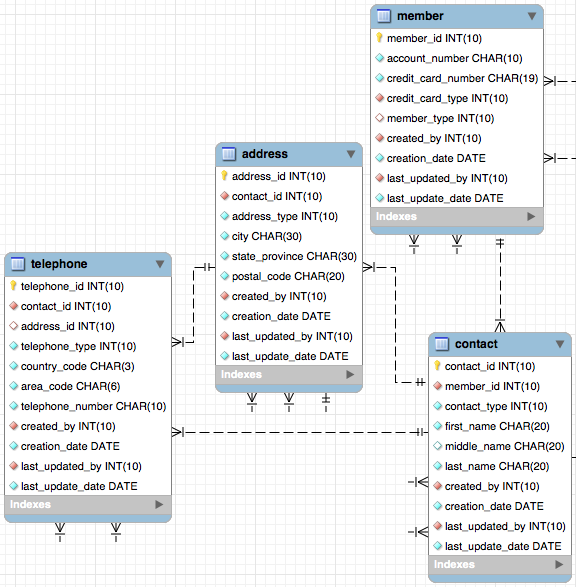Mandatory Relations
A foreign key constraint only guarantees that the value in the column will be a value found in a list values in another column. A foreign key constrained column also can hold a null value unless you also make the foreign key column a not null constrained column.
This ERD shows you the relationships between four tables:
If you follow the logic of the Entity Relationship Diagram (ERD), the columns with a filled red diamond are mandatory relations. The model depicts the mandatory relations qualified in the bullet points:
- The
membertable:- A
credit_card_typecolumn value must be found in the valid list of thecommon_lookuptable’s primary key column and must be not null constrained. - A
member_typecolumn value must be found in the valid list of thecommon_lookuptable’s primary key, but the column initially accepts a null value because it isn’t constrained by aNOT NULLconstraint.
- A
- The
contacttable:- A
member_idcolumn value must be found in the valid list of themembertable’s primary keymember_idcolumn; and themember_idcolumn also must be constrained by a not null constraint.
- A
- The
addresstable:- A
contact_idcolumn value must be found in the valid list of thecontacttable’s primary keycontact_idcolumn; and thecontact_idcolumn also must be constrained by a not null constraint.
- A
- The
telephonetable:- A
contact_idcolumn value must be found in the valid list of thecontacttable’s primary keycontact_idcolumn; and thecontact_idcolumn also must be constrained by a not null constraint. - A
address_idcolumn value must be found in the valid list of theaddresstable’s primary keyaddress_idcolumn; and theaddress_idcolumn is unconstrained or null allowed.
- A
You should notice that most of the foreign key columns are red, which means they are not null constrained. That’s the general pattern when a row can’t exist in a dependent table without a mandatory relationship to the table holding the primary key value.
